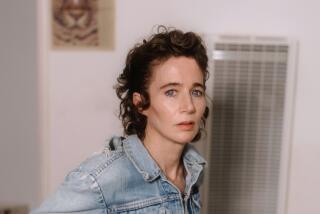Review: ‘The Lives of Margaret Fuller’ by John Matteson
- Share via
The Lives of Margaret Fuller
A Biography
John Matteson
W.W. Norton: 510 pp., $32.95
Margaret Fuller didn’t need to wear a meat dress to attract attention.
This socially awkward New Englander, this unabashed questioner and critic, this woman of not just her time but every time since, was an individual of such soaring intellect and opinion that her contemporaries—Emerson, Thoreau, Greeley, Poe and Hawthorne among them—regarded her with varying degrees of respect and antipathy.
Emerson asked her to serve as the editor of his transcendentalist journal the Dial, invited her for extended stays in Concord, Mass., for deep conversation and commented that, for Fuller, “humility was always an afterthought.” Thoreau had high regard for her writing — calling it “rich” and describing her style as “talking with a pen in hand” — and enjoyed their boat rides. Poe considered her a “busybody,” an intellectual anomaly of her sex, and published a sketch mocking her appearance: “the upper lip, as if impelled by the action of involuntary muscles, habitually uplifts itself, conveying the impression of a sneer.” Hawthorne would charm her in person and privately confide to friends that he was repelled by her “strong and coarse,” “defective and evil” nature.
Greeley, the newspaper editor and reformer, viewed Fuller’s educated opinions as an asset and hired her to become the New York Tribune’s first literary editor, despite his initial concern about her ability to meet deadlines. Greeley’s employment would change Fuller’s life by providing her with a steady income and an interesting social milieu and by allowing her to cast off familial obligations binding her to New England, first as a resident of New York City and then as the Tribune’s first international correspondent. (Actually, she was the first foreign newspaper reporter, male or female.)
At a time when domestic violence was not criminalized, when women could not own property, vote, attend college, smoke in public, wear pants or divorce, and when the medical establishment believed that women risked their mental and physical health if they engaged in intellectual pursuits, Fuller’s remarkable genius lay in her ability to lead a life of her own creation while trespassing into male territory.
Fuller was the recipient of her father Timothy’s ambition. A brooding thinker who was disappointed that his first child was female, Timothy gave his daughter an incredibly rigorous education that left her with nightmares and robbed her of her childhood. And though she was lauded as a prodigy, she was keenly aware as she matured that her father rued his role in developing her mind. She suffered from spinal curvature and migraines and was plain-featured, nearsighted, an unmarried mother at age 38, in love with an Italian man a decade younger and regularly criticized in private and public for her inability to be deferential in the slightest degree. Fuller was, quite simply, too fierce to fit in.
Margaret Fuller is a compelling individual because she relied on her intellect, not her sex, not the law, not wealth, not religion, not sentimentality, to argue why women deserved full rights to citizenry: that they were in every way equal to men. She made this argument to women and men in conversation and in everything she wrote. Her great desire was to cultivate a national American literary identity, and she believed literature was “a means of mutual interpretation.” Fuller craved educated discourse, and, in her view, “America had produced too many incentives to remain common.” Existence was to be considered, critiqued and held to the highest purpose. What an interesting notion these days.
In the 162 years since her death, Fuller has been relegated to the realm of American Renaissance and women’s studies scholars and those more interested in her ghoulish end rather than in her accomplishments. (She drowned at age 40 along with two members of her family just 50 yards off Fire Island, N.Y., after her ship slammed into a sandbar. Her body was never recovered.) In his new biography, “The Lives of Margaret Fuller,” John Matteson aims to return Fuller to her rightful place among our leading writers and thinkers.
Matteson deftly describes Fuller’s milieu and times while tracing her footsteps as she comes of age in Cambridge, Mass., travels through the Midwest (a trip that resulted in her travelogue “Summer on the Lakes”) and moves to New York City (where she completed the incandescent book “Woman in the Nineteenth Century”) and to Europe, where she witnessed and supported Giuseppe Mazzini’s failed Italian revolution. In the midst of all this detail, Fuller chats with Carlyle, meets Wordsworth, is intrigued by George Sand, hears Chopin play as his guest and is friendly with Robert and Elizabeth Barrett Browning.
There is the sense, in reading this litany — to borrow from Edith Wharton — that we are “human sightseeing” without necessarily getting under Fuller’s skin. What must it have been like to always be the smartest person in the room without any of the privileges accorded to men?
This distance is reinforced when the occasional jarring note is struck, as when Matteson opines, in describing Fuller’s childlike prose sent to James Nathan, a romantic interest, that a man who wants “to maintain a romantic mood with a woman who continually presents herself as a little girl requires patience indeed, to say nothing of a certain tolerance for creepiness.” But as a woman deprived of her childhood, struggling to earn a living, having to regularly defend her views, perhaps she felt she could relax, take a trusting breath and enjoy a simpler, safer place.
The timing of this biography is fortuitous in that efforts, led by Meryl Streep, are underway to establish a National Women’s History Museum. Congressional approval is needed and a bill to allow the museum has passed committees in the House and the Senate and is awaiting action by the full legislative bodies.
Certainly Margaret Fuller is a fitting example of why such a public museum is long overdue. In the midst of tracing her comings and goings, Matteson aptly demonstrates that Fuller — thanks to her enormous mind and unflinching tenacity in an era bent on silencing women and relegating them to the gallery — deserves much more of our attention. We will all be the better for it.
Skandera Trombley’s most recent book is “Mark Twain’s Other Woman: The Hidden Story of His Final Years.” She is the president of Pitzer College.
More to Read
The biggest entertainment stories
Get our big stories about Hollywood, film, television, music, arts, culture and more right in your inbox as soon as they publish.
You may occasionally receive promotional content from the Los Angeles Times.










